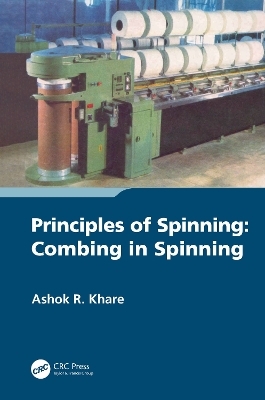
Principles of Spinning
CRC Press (Verlag)
978-1-138-59659-7 (ISBN)
Principally focussed on the combing process, the initial chapters of this book explain the basic functioning of the conventional comber, which is not very different from modern combing. Various associated motions with reference to certain timings along with importance are illustrated in detail. Characteristics that set the modern comber apart are also discussed including speed and control of features such as vibrations and fatigue. The role of modern electronics in mechanism control, including related calculations and solved examples, is described.
Features:
Exclusive title focussing on various elements of combing in spinning.
Includes detailed functioning of conventional and modern combers.
Explains various motions in combing pertaining to different timings.
Discusses the role of modern electronics in controlling the mechanisms and offering online controls.
Features solved examples at the end to tackle problems at the shop-floor level.
This book is aimed at senior undergraduate/graduate students, textile process engineers and related manufacturing technologists, quality assurance professionals in textile engineering, staple fibre processing, spinning of staple fibres, textile marketing/design, textile technology, yarn manufacturing, spinning machines and design of yarns.
Ashok R. Khare is a graduate, post-graduate and doctorate from a well-known technological institute – Veermata Jijabai Technological Institute, Mumbai (formerly known as Victoria Jubilee Technical Institute). He graduated from this Institute in 1970 and went to serve a well-known textile group of Mafatlal mills. After serving for nearly 5 years in the textile mills, he returned back to his Alma mater in 1975 as a lecturer in textile technology. In the due course, he was promoted to Assistant Professor and Professor. In the last phase of his service in V.J.T.I., Mumbai, he took over as the Head of the Textile Manufacture’s Department. Almost during the same tenure, he held a position of Deputy Director in the same Institute. He has written several articles on card cleaning efficiency, role of uni-comb, extended research work on influence of doubling parameters on properties of blended doubles yarns.
1. Combing Preparation. 2. Preparation for combing. 3. Comber. 4. Important Comber Settings. 5. Cylinder & Top Comb Needling Arrangement. 6. Other Aspects. 7. Faults in Comber. 8. Features of Modern Comber. 9. Comber Calculations
| Erscheinungsdatum | 03.01.2024 |
|---|---|
| Reihe/Serie | Principles of Spinning |
| Zusatzinfo | 16 Tables, black and white; 161 Line drawings, black and white; 4 Halftones, black and white; 165 Illustrations, black and white |
| Verlagsort | London |
| Sprache | englisch |
| Maße | 156 x 234 mm |
| Gewicht | 453 g |
| Themenwelt | Kunst / Musik / Theater ► Design / Innenarchitektur / Mode |
| Naturwissenschaften ► Chemie ► Organische Chemie | |
| Naturwissenschaften ► Chemie ► Technische Chemie | |
| Technik ► Umwelttechnik / Biotechnologie | |
| ISBN-10 | 1-138-59659-0 / 1138596590 |
| ISBN-13 | 978-1-138-59659-7 / 9781138596597 |
| Zustand | Neuware |
| Haben Sie eine Frage zum Produkt? |
aus dem Bereich


